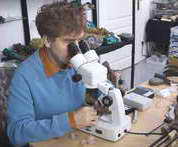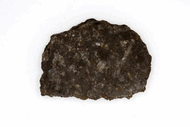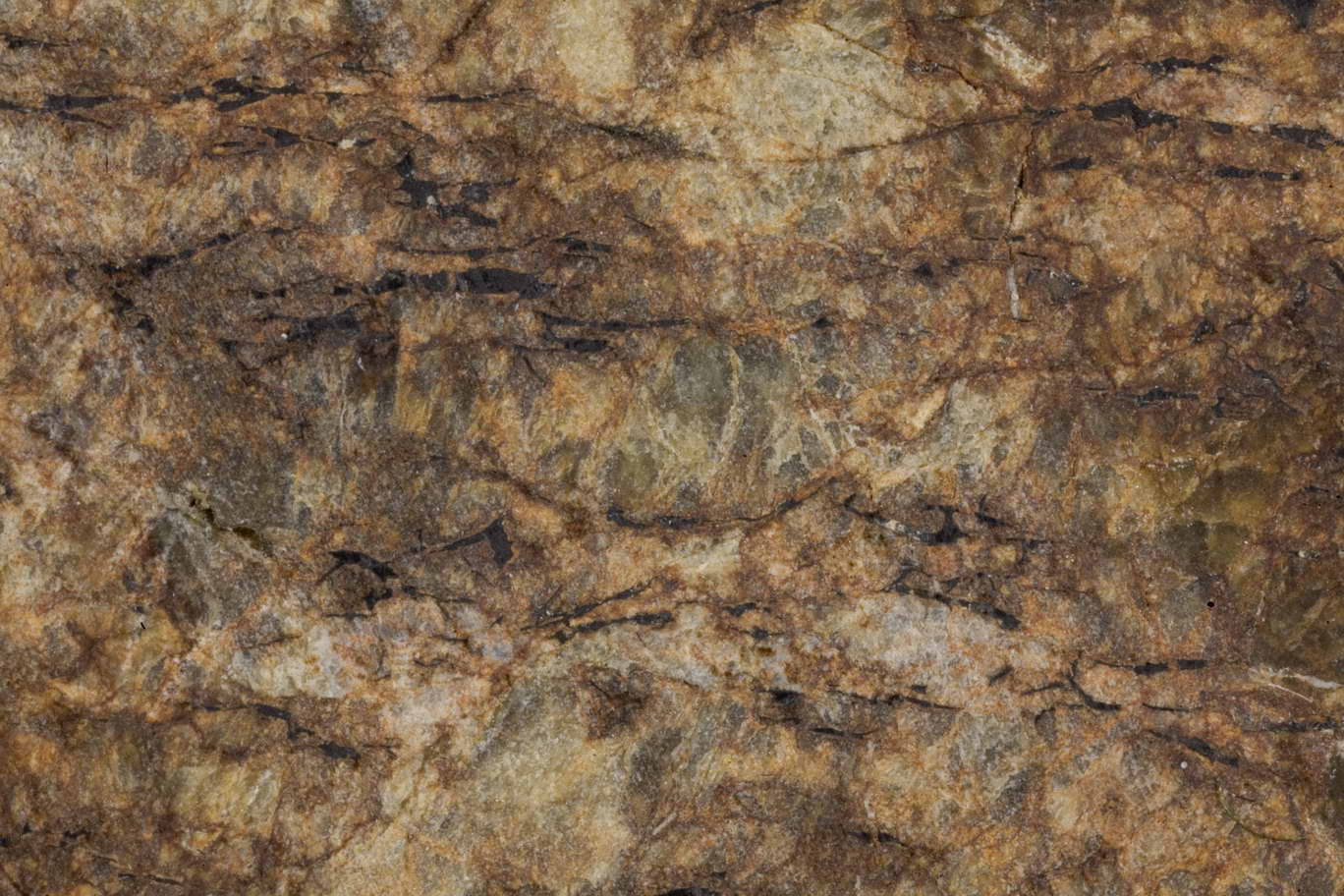Ureilites
|
||||
|
Ureilites
are a rare class achondrites
mostly rich
in carbon often in the form of diamond Ureilites are in contrary to many achondrites not igneous differentiates, but ultramafic meteorites, which are almost always highly fractionated. They are composed mainly of magnesian olivine, pyroxenes (often occuring as pigeonite crystals), free (Ni-)Iron, graphite and diamond inclusions. Their mineral and oxygen isotopic compositions suggest that they formed as residues from partial melting. Despite the fact that ureilites have undergone a planetary differntiation history process, to some degree of surprise they also have primitive characteristics (like presence of free NiFe and oxygen isotopic signature of primitive/unequilibrated solar system materials). There
textures is often medium- to coarse-grained. The black fusion due to
high carbon content black. As
many ureilites contain poly-cristalline nano-diamonds, they are pretty
hard to cut. The ureilites are subdivided into two main groups:
|
||||
|
Please click below on underlined meteorite title names to see more detailled descriptions |
||||
|
Monomict Ureilite (unclassified) from Northwestern Africa: nice material: $8/gr available: 4g, 16gr, 63gr |
||||
| Almahata
Sitta, heterogenous material reaching from anomalous coarse-grained and porous ureilite to material with more fine-grained and well-consolidated ureilitic texture 0,65g sold! 0.83g 7x7mm sold; 1.2g slice AURE coarse grained with tiny Suessite trace 13x13x3mm $550, 1.1g slice AURE medium grained 11x13x3mm $490 |
||||
|
polymict ureilite, Name : DAG 319 (FeO/MgO) Dar al Gani , highly beautiful, diamonds! Primitive clasts in the Dar al Gani 319 polymict ureilite: Precursors of the ureilites (Ikeda et al) Lithic and mineral clasts in the Dar Al Gani (DAG) 319 polymict ureilite (Ikeda et al) 0,40g 5x5mm slice $29, slice 0.51g 6x7mm $53 ; 0,65g sold! 0.63g 7x7mm sold; 1.15g slice 10x13mm; 1 bug box (appr.0.15g appr.5x3mm) : $ 13 comes complete with certificate! |
||||
|
DaG 868 - Ureilite (unshocked diamondrich) Ureilites containing diamonds were always thought to have been formed by impact shocks. A new type of Ureilite ( DaG 868 ) has been discovered and was published now. The features of DaG 868 seem to suggest that reconsiderations about the origin and building history of ureilites are necessary now: The Ureilite is containing fine-grained diamonds but olivines appear to be unshocked (show no evidence of undulose extinction!) - Graphite found in pigeonite crystals in DaG 868 however contain diamonds! This suggests that the diamonds have not(!) been formed by shock impact or chemical vapor deposition and such raises major questions about building history of ureilites. Catalytic transformation of graphite to diamond will be a mechanism to be considered for this new ureilite type. Such DaG 868 falls in an own group of " weakly shocked diamonds "with" the presence of diamonds" with ALH 78019 and 78262.. History: A 40.03 g ureilite meteorite was found on 13th of April of 2000 by anonymous finder in DaG in the Central Saharan desert. Classification and mineralogy (H.Takeda,Chiba and M. Ohtsuki UTok): the ureilite meteorite has a typical texture for ureilites consisting of anhedral to subhedral olivine and pigeonite (0.9 – 3 mm across); Carbonaceous material forms rims around some grains or, in some cases, veins; one plate of graphite occurs within a large pigeonite crystal; The interesting fact on this material is that the olivines appear to be unshocked compared to most ureilites, and have homogeneous cores (Fa20.6) and reduced rims (Fa8) with high CaO contents (0.25-0.38 wt.%); pigeonite,Fs16.8Wo7.5. X-ray diffraction and reflected light microscopy (T. Nakamura and T. Nakamuta, KyuU) confirm the presence of fine-grained diamonds in a graphite lath. Specimens: main mass with anonymous finder; type specimens, 6.33 g, NSMT; 1.8 g,KyuU. Ultrathin slices BB $35; 0.1g sold ; 0,24g; 0,8g 16x15mm slice; 0.5g sold 1,57g 30x14mm almost complete slice sold 3,7g segment $350/gr Please kindly ask for availability of slices: eric@mars.li |
||||
|
DaG 976 - polymict Ureilite with (prov.) CI inclusions: 1 meteorite of 32.033g was found 1999 Aug.20th available are thin slices of 0,4g sold/traded, 1.4 g, 1,5g sold/traded 0.9g 18x16mm @ $175/gram Please ask for availibility and price (limited supply) : eric@mars.li |
||||
|
A total mass of 17g crust was found 2000 in the desert region of DaG, Al Juffrah Available are slices of 0,1g sold; 0.41 g sold, 0,55g sold; 0.89g 14x12mm, endpiece 1,3g @ $88/gram; representative large slice of 1.7g $130S Thin sections (PTS): $99/pce. |
||||
|
polymict ureilite - DaG 999 Found 2000 April 14 Numerous fragments totaling 2,106 g were found on 2000 April 14 in the sand desert of Dar al Gani. Classification and mineralogy: (A. Greshake and M. Kurz): a fragmental breccia with mineral and lithic clasts set into a ureilitic matrix dominated by large olivines; olivine core, Fa14.3-23.5; reduced olivine rims, Fa2.9-13.5; mineral clasts are pigeonite, Fs14.3Wo8.5 and orthopyroxene, Fs9.3; lithic clasts consist of fine-grained olivine (Fa22) and pyroxene (Fs19.3Wo4.5) rich material; shock stage, S3; low degree of weathering. type specimen 20.8 g plus one polished thin section MNB 3g; 3.7g; 4.5g @$65/g; 76.8g; 111g Available only through us! Special:
polymict Ureilite DaG999 - 39.8g polymict Ureilite (with Enstatite - pyroxene), polymict - Dar al Gani 1023 DaG
1023 is one of the world's most heavily shocked ureilites. It
contains the extremely rare Ferro-Silicide Suessite. This surprising
ureilite displays also a few explicit chondrules.
Found August 19th 1999 , Dar Al Gani plateau Al Juffra. A ureilite meteorite of 149 g was found by an anonymous collector in the Dar al Gani desert. Mineralogy and classification (H. Takeda, Chiba; T. Ishii and M. Ohtsuki, UTok): fragmental breccia, with lithic and mineral clasts embedded in a cataclastic matrix of predominantly ureilitic material. Lithic clasts and fragments include mafic ureilitic material (olivine 86 vol. % and pyroxene 12 vol. %), Na- rich plagioclase fragments and rare subrounded, dark brown Na-, K- rich glassy grain (SiO2 68 wt. %, Al2O3 13.6 wt. %, MgO 5.6 wt. %, CaO 5.3 wt. %, Na2O 6.3 wt. %, K2O 0.8 wt. %). The pyroxene composition ranges from En79Wo6 to En62Wo4 and En59Wo31; olivine composition ranges from Fo90 to Fo75. The plagioclase composition ranges from An13Ab85 to An33Ab62. A slice of a lithic clast of 3.7 2.7 cm in size (subsample ,02; 6.89 g slice), is one of the most heavily shocked ureilites known. All mafic silicates are converted into very fine grained materials with a granoblastic texture; carbonaceous vein materials are lost from many grain boundaries; glassy shock-vein materials are observed at some parts of the thin section. Olivine (80 vol. %) is more abundant than pyroxene (20 %). Pyroxene composition ranges from En86Wo2 to En77Wo10 and En69Wo6; olivine composition ranges from Fo96 to Fo66. The ureilite meteorite is weathered, with a brownish colour in hand specimen, but in thin section the weathering grade appears to be very low. Specimens: type specimen, 20.752 g (including sample ,02), NSMT, one thin section, Chiba; main mass with anonymous finder. 0.49g, segment; 0.58g slice sold; 1.1g sold; 2.8g slice 28x24mm ; 3.1g slice no pairing - Available only through us!
|
||||
|
polymict Ureilite - DaG 1047 A ureilite meteorite of TkW: 49.8 g was found 16-May-1999 by an anonymous collector in the Dar al Gani desert. Classification: Meteoritical Bulletin: Comments: Approved 24 Jul 2007 Data from: MB92 Table 1 Shock stage: Mod ; Weathering grade: Moderate contains
the extremely rare Ferro-Silicide Suessite and shows a few explicit
chondrules Fayalite (mol%): 3.6-22.4, Ferrosilite (mol%): 3.7-22.4, Type spec mass (g): 10.2 Info: Classified: A. Greshake, MNB. Type specimen: MNB. Main mass: Anonymous. Comments: Polymict breccia with fine-grained chondritic lithologies only few small segments of up to 6mm max diam are left of this rare Ureilite type Please ask for availibility (limited supply) : eric@mars.li erich.haiderer@chello.at |
||||
|
available: thin slice 0.33g 7x7mm $30 ; 1g 12x14mm $70; 2.9g slice $190 |
||||
|
1 fresh looking, oriented ureilite meteorite (split up in 1 big and 1 small pieces) with large greenish olivine clasts of 995g was found on 15.8.2002 in the sand desert 0.34g
- 7x10x6mm fragment $48 |
||||
|
rare type 2 Ureilite (such as Hajmah (a), Donga, or Dyalpur): Dho 837 |
||||
|
JaH 054 polymict Ureilite 1,4g slice 15 x11mm, endpiece 2.5g, $110 BB $16 Please ask for availibility erich.haiderer@chello.at |
||||
|
New! Very Unusual, Surprising: type 2 - Ureilite Ureilite - NWA 1241 contains the rare mineral Suessite which is a very rare metalic mineral with the composition: (Fe,Ni) 3 Si with very low Ni content (appr. 1-3) indicating that this material is rather not from an asteroidic parent body. type 2 - Ureilite (such as Hajmah (a), Dingo Pup Donga, or Dyalpur) Classification and mineralogy: (F.Wlotzka, MPI, and M. Kurz, Germany) TkW:
282g covered with fresh fusion crust. Intermediate
(type 2 - medium reduced! ) FeO/MgO ratio in olivine cores: Olivine has
Fo 80-83 in the cores (with 0.7 -1.7% Cr2O3, 0.2-0.6% CaO). Carbonaceous
matrix is rare, graphite occurs in fine-grained patches. Coarser white
reflecting grains are Suessite, (Fe,Ni)3Si, with 13% Si, 2.5% Ni (range
1-4%), 1.1% Cr. This rare mineral is The mineralogy of NWA 1241 suggests that it was formed at extreme pressures of appr. 100 bars and equilibration temperatures of more than 1200°C! This NWA 1241 is a valuable sample for understanding the thermal history of ureilites parent body. NWA1241
is an unusual monomict ureilite, consisting mainly of pigeonite,
olivine, suessite, and carbonaceous materials. The
modal ratio of pyroxene/(olivine+pyroxene) is higher than those of
common monomict ureilites. Metallic
phases in NWA1241 are mainly suessite, although metals in common
ureilites are mainly kamacite. The
high ratio of pyroxene to olivine and the abundant occurrence of
suessite make the meteorite unusual. Minor weathering. Type specimen: 20.5g MPI.
0.2g slice 4x5mm with crust sold; 0.24g slice 4x7mm with crust ; 1.13g sold 1.24g slice with crust ; 3.10g beautiful slice with crust ; 13g sold12x 7 mm ; 21x16 mm ; 2.5 gr 34 x 37 mm Price: $190/gr |
||||
|
Ungrouped Achondrite from prev. Ureilite - NWA 1500 - Prov. the first basaltic ureilite! New analysis suggest that this highy interesting achondrite could be brachinite related and probably originated from the Winona group parent body and may not come as originally thought from the Ureilite parent body. Studied by: Frank Wlotzka, B.Clayton, R. Bartoschewitz, Goodrich thin slices $155/g; endpieces with crust $150/g |
||||
|
NWA 3077 - AURE almost diamond free 1 piece partly covered with fresh fusion crust of 11.213g was found early 2003 in the Occidental Sahara rare Ureilite type; thin part slice with/without crust. Let us kindly know which price/size range you might be interested in! 0,3g; 1,01g; Price BB $22 |
||||
|
Shisr 007 - Ureilite Total recovered mass: 9.024 kg. Classification: Typical texture of coarse (1-3 mm), equigranular olivine (cores Fa 19.4, Cr2O3 0.55%) pigeonite (Fs 17.4, Wo 9.0, Cr2O3 1.2%). Classified by F. Wlotzka, Max-Planck-Inst. fur Chemie Dep.:Bartoschewitz thin slices and segments: 1.9g; 2.4g; 3.8g Price |
||||
|
All Specimens Subject To Prior Sale We reserve the right to refuse to sell to individuals or groups with giving reasons! View Customer Comments & Validations: If you are happy with our shipment you can recommend your satisfaction to friends, lists or forums. Thank you very much! Please download kindly certificates for meteorites you purchased from us from our download site:  |
||||
|
|




